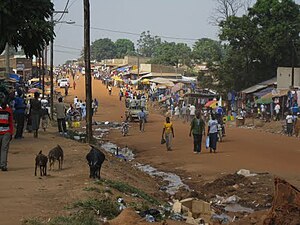Yei, Sudan
| Yei | |
|---|---|

Yei landscape
|
|
| Location in South Sudan | |
| Coordinates: 04°06′00″N 30°40′12″E / 4.10000°N 30.67000°E | |
| Country |
|
| State | Yei River State |
| County | Yei River County |
| Population (2014 Estimate) | |
| • Total | 260,720 |
| Climate | Aw |
Yei is a medium-sized city in South Sudan's southwest. It lies close to the borders of two of the country's trading partners, Uganda and the Democratic Republic of Congo. It is a business hub, attracting traders and customers from all three countries. Ivory Bank and Kenya Commercial Bank maintain a branches in the city. Yei is served by Yei Airport.
The city of Yei is located in Yei County, Yei River State in southwestern South Sudan, close to the international borders with the Democratic Republic of the Congo and the Republic of Uganda. It is approximately 170 kilometres (110 mi), by road, southwest of Juba, the capital and largest city in South Sudan. The geographic coordinates of the city of Yei are: 4° 6' 0.00"N, 30° 40' 12.00"E (Latitude: 4.1000; Longitude: 30.6700).
The name Yei was given to the location where the current city stands by (traditional chiefs of Kakwa- Chief Gbongale Dada Southern Kakwa, Chief Banja Aligo- Central Kakwa people;; Chief Tombura Tumbura Eastern Kakwa people; Chief Baraba Minde- Western Kakwa people; Pojulu -Chief Ramadala Lomodo for Dimo Pojulu area; Chief Lungaju Ladu for Terepe, Pojulu people; Chief Kundu Lokule for Lokurubang Pojulu people; Mundu- Chief Mungwa for Mundu people; Makaraka- Chief Muktar for Makaraka people; Keliko - Chief Aluma Aligo for Keliko people; Avokaya - Chief Gada for Avokaya people and Baka- Chief Waraga Igbeke for Baka people. But not three traditional chiefs, from the mentioned communitiesPojulu, Gimunu and Azande ethnic groups. This very area was named so because it used to be a center for collection of food products which were contributed in form of taxes by the chiefs from all over the territory farmers for facilitation of administrative services in the district. People used to carry these collected food products from a long distances to take them to the main administrative center called 'Laliok' in current Lainya County. The Purspose of changing the district center from Laliok to Yei Town was due to lack of adequate water sources in Lainya County. The same chiefs also conferred the name to the river that flows through the area and is now called River Yei. The Kakwa ethnic group exists in the current three Countries namely Uganda, South Sudan and DRC. They were broken into these three countries by the colonial rulers interests. But they continue to co-exist because of cultural and traditional relationships. This coexistence is known as " Salia Musala" which means Tripartite relationship. The Kakwa lived in co-eexistance with other smaller ethnicities without conflicts until politicians got into games of divide and rule. It was because of instigators which caused the people from different ethnicities in Yei to rival from time to time. In 1917, British missionaries built a small medical clinic on the northern bank of River Yei and established elementary schools as well as the government head offices. That is how the town was born. After the end of the first civil (1955-1972), many people returned from exile back to Yei town. People coming from diaspora had different experiences and different world views. They started to implement what they collected from East Africa, particularly from Uganda, Kenya, Tanzania and also from Europe. The Yei people's behavior portrayed that of very civilized, social and religious persons. Very hard working and creative ethnic group of people developed in what became Greater Yei District. Most Yei people improved their subsistence agricultural farms and moved to cash crop farming. Coffee and Tea leaves were produced here and sold to the Arab world. Arab traders bring cars for sale in Yei, Kaya, Aboroto, and Baazi. This made business people and expatriates who likes Yei weather and its forests to call the zone as "Small London" <Idoru Nyama: 2001>
...
Wikipedia

